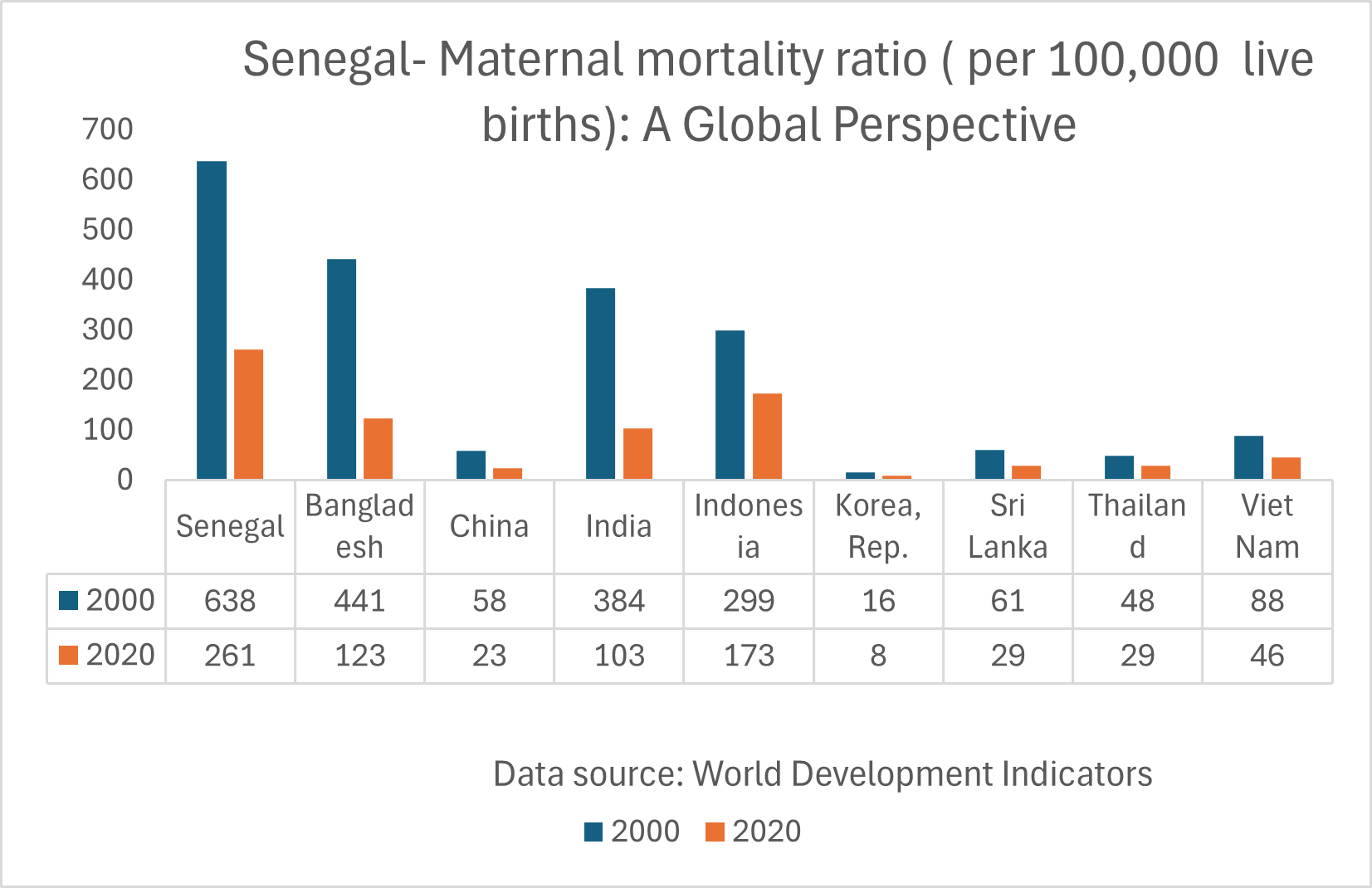
Senegal
Country Flag Details
three equal vertical bands of green (hoist side), yellow, and red with a small green five-pointed star centered in the yellow band; green represents Islam, progress, and hope; yellow signifies natural wealth and progress; red symbolizes sacrifice and determination; the star denotes unity and hope
note: uses the popular Pan-African colors of Ethiopia; the colors from left to right are the same as those of neighboring Mali and the reverse of those on the flag of neighboring Guinea.
Background
The French began to expand onto the Senegalese mainland in the second half of the 19th century and made it a French colony. The French colonies of Senegal and French Sudan were merged in 1959 and granted independence in 1960 as the Mali Federation. The union broke up after only a few months. Senegal joined with The Gambia to form the nominal confederation of Senegambia in 1982. The envisaged integration of the two countries was never implemented, and the union was dissolved in 1989.
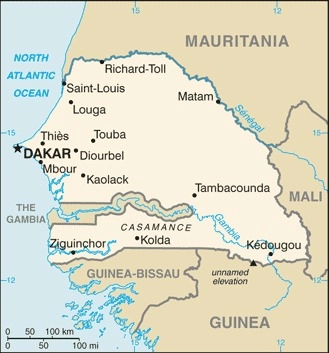
Geography
Area
total : 196,722 sq km
land: 192,530 sq km
water: 4,192 sq km
Climate
tropical; hot, humid; rainy season (May to November) has strong southeast winds; dry season (December to April) dominated by hot, dry, harmattan wind
Natural resources
fish, phosphates, iron ore
People and Society
Population
total: 18,847,519
Ethnic groups
Wolof 39.7%, Pulaar 27.5%, Sereer 16%, Mandinka 4.9%, Jola 4.2%, Soninke 2.4%, other 5.4% (includes Europeans and persons of Lebanese descent) (2019 est.)
Languages
French (official), Wolof, Pulaar, Jola, Mandinka, Serer, Soninke
Religions
Muslim 97.2% (most adhere to one of the four main Sufi brotherhoods), Christian 2.7% (mostly Roman Catholic) (2019 est.)
Population growth rate
2.46% (2024 est.)
Government
Government type
presidential republic
Capital name: Dakar
Executive branch
chief of state: President Bassirou Diomaye FAYE (since 2 April 2024)
head of government: Prime Minister Ousmane SONKO (since 2 April 2024)
Economy
Real GDP (purchasing power parity)
$78.045 billion (2023 est.)
$74.624 billion (2022 est.)
$71.874 billion (2021 est.)
Real GDP per capita
$4,300 (2023 est.)
$4,200 (2022 est.)
$4,200 (2021 est.)
Exports
$6.78 billion (2021 est.)
$5.063 billion (2020 est.)
$5.836 billion (2019 est.)
Exports – partners
Mali 21%, India 12%, Switzerland 11%, China 5%, UAE 4% (2023)
Exports – commodities
gold, refined petroleum, phosphoric acid, fish, cement (2023)
Imports
$12.278 billion (2021 est.)
$9.627 billion (2020 est.)
$9.17 billion (2019 est.)
Imports – partners
China 19%, France 9%, Nigeria 7%, India 7%, Russia 5% (2023)
Imports – commodities
refined petroleum, crude petroleum, rice, garments, wheat (2023)

Export structure by product group in 2023 (% of total export) (UNCTAD)
The export structure of a country encompasses the variety, composition, and value of its goods and services traded internationally, providing crucial insights into its economic vitality, competitiveness, and developmental stage. In the case of Senegal, the country boasts a rich and diverse export structure that includes an array of minerals, precious metals, seafood, agricultural products, and various manufactured goods. This broad spectrum of exports not only showcases Senegal’s natural resources and industrial capabilities but also strengthens its ability to adapt to shifts in the global marketplace. By embracing such diversity, Senegal fosters a more resilient economy that is well-equipped to navigate changes and uncertainties, ultimately contributing to sustainable economic growth and development.
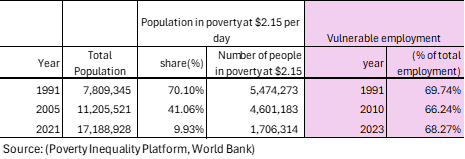
Poverty and Vulnerable employment in Senegal (World Bank)
In 2023, 68 percent of total employment in Senegal was deemed vulnerable, a term referring to jobs with inadequate job security, low wages, and a significant absence of essential social protections such as health insurance, pensions, and basic labor rights. This vulnerable employment category primarily encompasses own-account workers, who operate independently without hiring employees—examples include street vendors, artisans, and small-scale farmers—as well as contributing family workers, who assist family businesses or farms without formal remuneration. The alarming statistic highlights that a substantial portion of Senegal’s labor force is engaged in these precarious positions, which are often informal and unstable, leaving workers highly vulnerable to economic fluctuations, exploitation, and the persistent threat of poverty. As a result, the lives of these individuals are filled with uncertainty and hardship.
Understanding poverty level significance at $2.15 per day
In 2021, nearly 10 percent of the population in Senegal lived in poverty at $2.15 per day. The poverty level at $2.15 per day (measured in 2017 purchasing power parity, or PPP) is a key global benchmark used by the World Bank to define extreme poverty in low-income countries. It indicates:
1. Basic Survival Threshold
• People living below $2.15 per day struggle to afford essential needs such as food, clean water, shelter, healthcare, and education.
2. Economic Underdevelopment
• A high percentage of a country’s population living below this threshold suggests low economic productivity, high unemployment, and weak social safety nets.
3. Inequality and Social Vulnerability
• It reflects deep income inequality and a lack of access to opportunities for upward mobility.
• People in this category are more vulnerable to shocks like food price increases, climate disasters, or health crises.
4. Policy Challenges
• Governments need targeted interventions such as social welfare programs, job creation, and improved access to education and healthcare to reduce poverty.
A country's export structure is a reflection of its level of development and productive capacities
The export structure of a country refers to the composition, diversity, and value of the goods and services it sells to other countries. It provides key insights into the country’s economic health, competitiveness, and level of development. Productive capacities of a country refer to its ability to produce goods and services efficiently and sustainably over time. These capacities are shaped by various factors, including human capital, natural resources, infrastructure, private sector, development, technology & innovation, institutions & governance, financial systems trade & market access.
Here’s what the export structure and productive capacities of a country typically indicate:
- Level of Economic Development
- Developed economies usually export high-value manufactured goods, technology, and services.
- Developing economies often rely on raw materials, agricultural products, or low-value manufactured goods.
- Industrial and Sectoral Strengths
- A strong presence of high-tech or industrial goods (e.g., machinery, electronics) suggests a well-developed manufacturing sector.
- A dominance of commodities (e.g., oil, minerals, agricultural products) indicates reliance on natural resources.
- Export Diversification
- A diverse export base (multiple industries) makes a country’s economy more stable and resilient to global price shocks.
- A concentrated export base (few key products) makes it vulnerable to market fluctuations.
- Trade Partnerships and Dependence
- If exports are heavily dependent on a single country or region, the economy is more exposed to geopolitical and trade risks.
- A wide range of trading partners indicates stronger global integration.
- Competitiveness and Value Addition
- Exporting mainly raw materials (e.g., crude oil instead of refined petroleum) suggests limited industrial processing capacity.
- A high share of finished and high-tech goods suggests strong value addition and competitiveness.
Senegal-Sanitation
Senegal – Proportion of population served with at least basic sanitation
In 2022, proportion of population served with at least basic sanitation for Senegal was 60.2 %. The proportion of the population served with at least basic sanitation of Senegal increased from 36.8 % in 2000 to 60.2 % in 2022, an absolute change of 23.4 percentage points (pp) between 2000 and 2022.
Senegal – Proportion of urban population served with at least basic sanitation
In 2022, proportion of urban population served with at least basic sanitation for Senegal was 70.2 %. Proportion of urban population served with at least basic sanitation of Senegal increased from 60.7 % in 2000 to 70.2 % in 2022 an absolute change of 9.5 pp between 2000 and 2022.
Senegal – Proportion of rural population served with at least basic sanitation
In 2022, proportion of rural population served with at least basic sanitation for Senegal was 50.5 %. Proportion of rural population served with at least basic sanitation of Senegal increased from 20.7% in 2000 to 50.5 % in 2022 an absolute change of 29.9 pp between 2000 and 2022.
Senegal – Proportion of population served with at least basic sanitation
The ongoing lack of safe sanitation is a critical issue that requires urgent action, resulting in preventable deaths for countless individuals each year and revealing a significant public health crisis. Access to safe sanitation is not just a basic necessity but a fundamental human right that everyone deserves. In 2022, about 7 million people—nearly 40 percent of Senegal’s population—faced the dire consequences of inadequate sanitation, showcasing a stark inequality compared to other countries. In contrast, Vietnam, China, and Thailand reported much lower figures with only 8 percent, 5 percent, and 1 percent lacking these essential services. The global average stands at around 6 percent, emphasizing the need for united efforts to improve sanitation access in underserved Sub-Saharan African nations, as addressing this issue is vital for healthier communities and equitable development in the region.
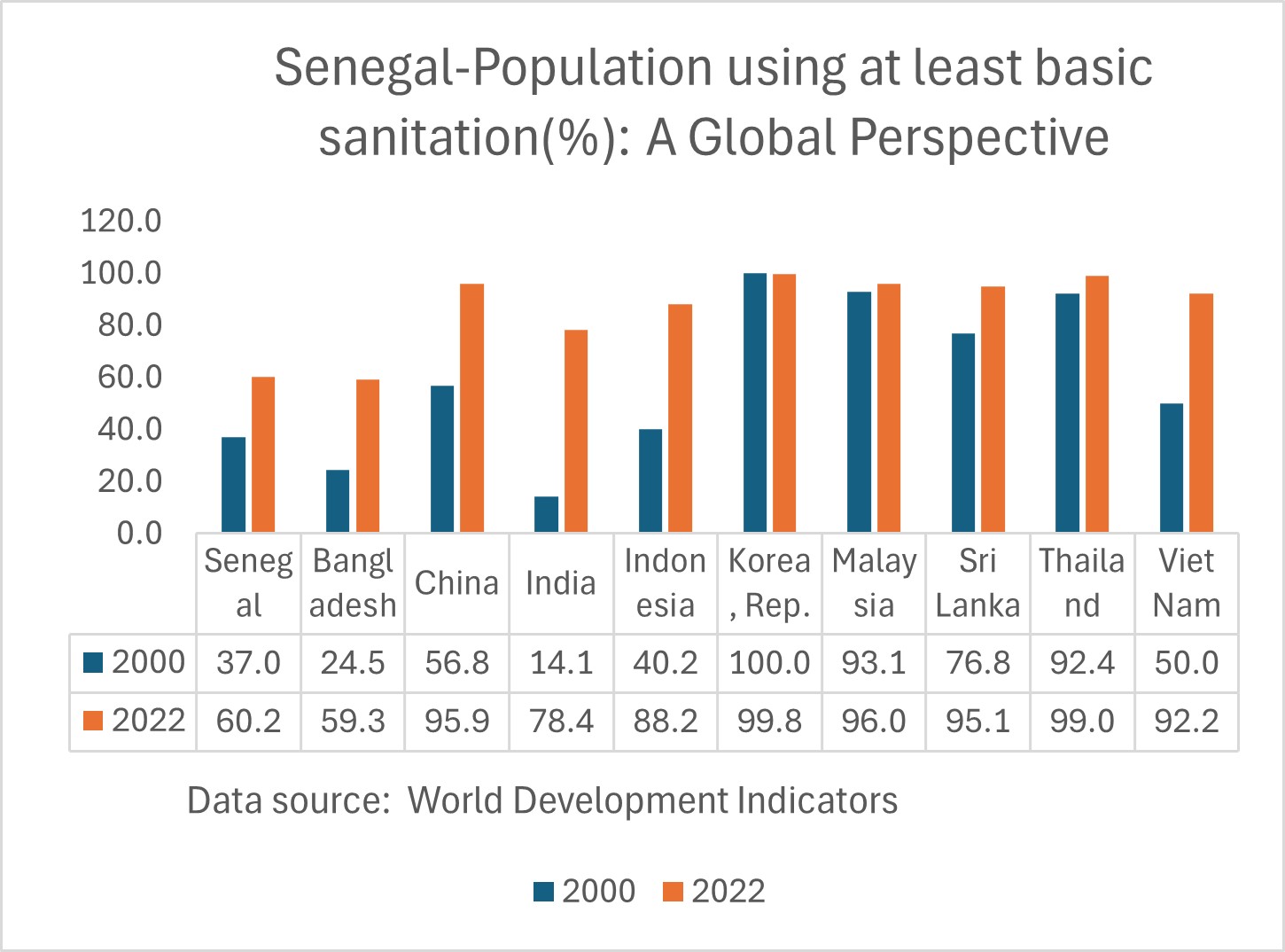
Senegal – Proportion of rural population served with at least basic sanitation
In 2022, nearly 4 million people in rural Senegal, or about 49 percent of the population, lacked access to essential sanitation facilities, a stark contrast to Vietnam, Sri Lanka, and Thailand, with rates of 12 percent, 5 percent, and 2 percent respectively. This alarming absence of safe sanitation is a critical challenge that demands immediate collective action, leading to preventable deaths and underscoring a public health crisis we cannot ignore. Access to safe sanitation is not just a basic need; it is a fundamental human right that everyone deserves. Thus, we must unite our efforts to advocate for and protect this right across Sub-Saharan Africa, where the need is urgent and the potential for community transformation is immense.
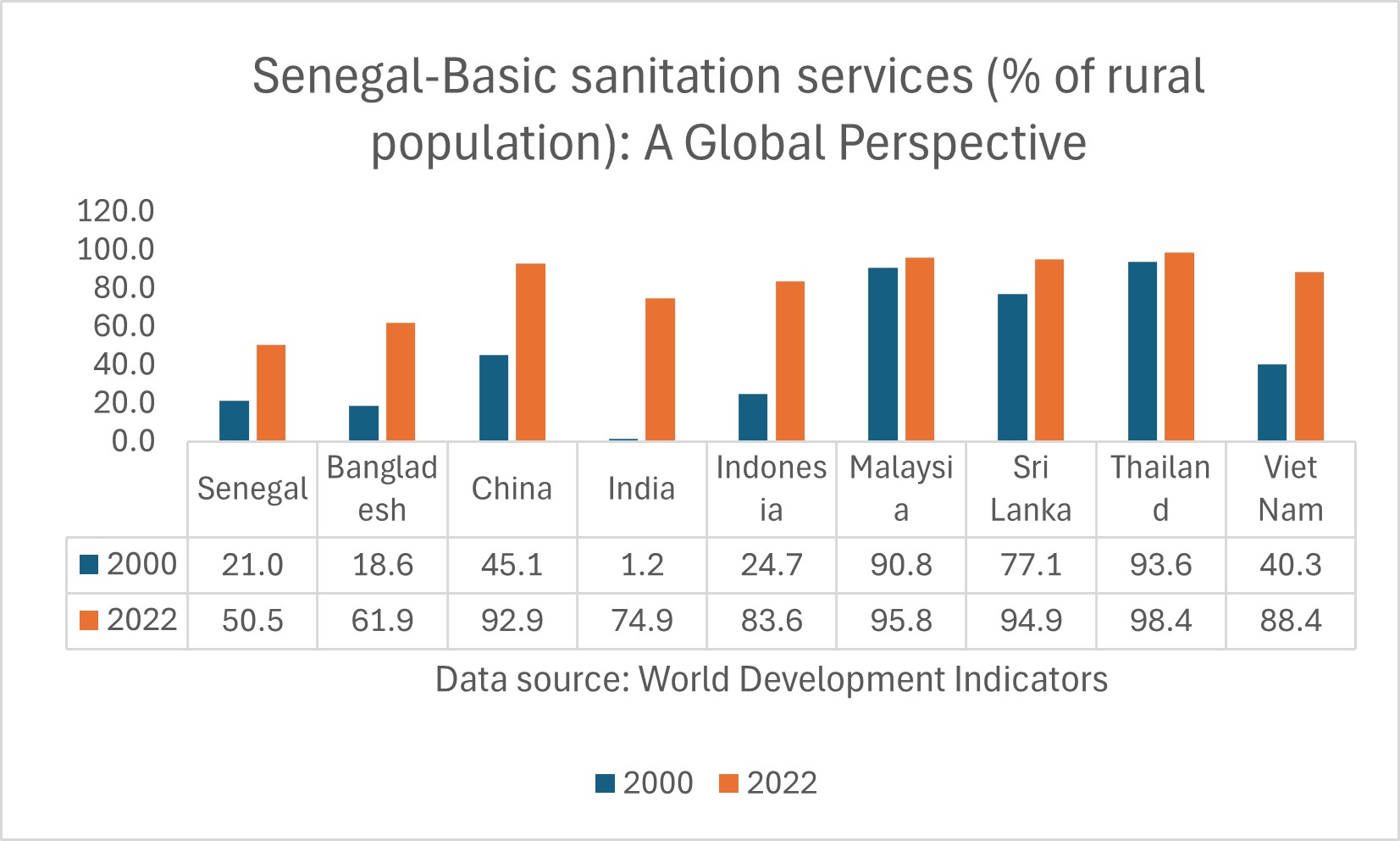
Senegal-Water Supply
Senegal – Proportion of total population served with at least basic drinking water
In 2022, the proportion of the population served with at least basic water for Senegal was 86.2 %. The proportion of the population served with at least basic water of Senegal increased from 58.0 % in 2000 to 86.2 % in 2022 an absolute change of 26.4 pp between 2000 and 2022.
Senegal – Proportion of urban population served with at least basic drinking water
In 2022, the proportion of the urban population served with at least basic water for Senegal was 95.9 %. The proportion of the urban population served with at least basic water of Senegal increased from 88.2 % in 2000 to 95.9 % in 2022, an absolute change of 7.7 pp between 2000 and 2022.
Senegal – Proportion of rural population with at least basic water
In 2022, the proportion of the rural population served with at least basic water for Senegal was 77 %. The proportion of the rural population served with at least basic drinking water in Senegal increased from 40.5% in 2000 to 77 % in 2022, an absolute change of 36.4 pp between 2000 and 2022.
Senegal – Proportion of total population served with at least basic drinking water: A Global Perspective
Access to safe drinking water is a fundamental human need and a crucial right essential for health and well-being. In 2022, nearly 2.5 million people in Senegal, about 14 percent of the population, lacked this vital resource, highlighting significant inequality in access to necessities many take for granted. In stark contrast, everyone in Thailand had access to safe drinking water, and 98 percent of people in Bangladesh and Vietnam enjoyed this same right. These disparities underscore the urgent need for compassionate actions to improve living conditions and ensure equitable access to safe drinking water for vulnerable communities in Sub-Saharan Africa. The severe consequences of these inequities demand our immediate attention and decisive action to create a more just and equitable future for all.
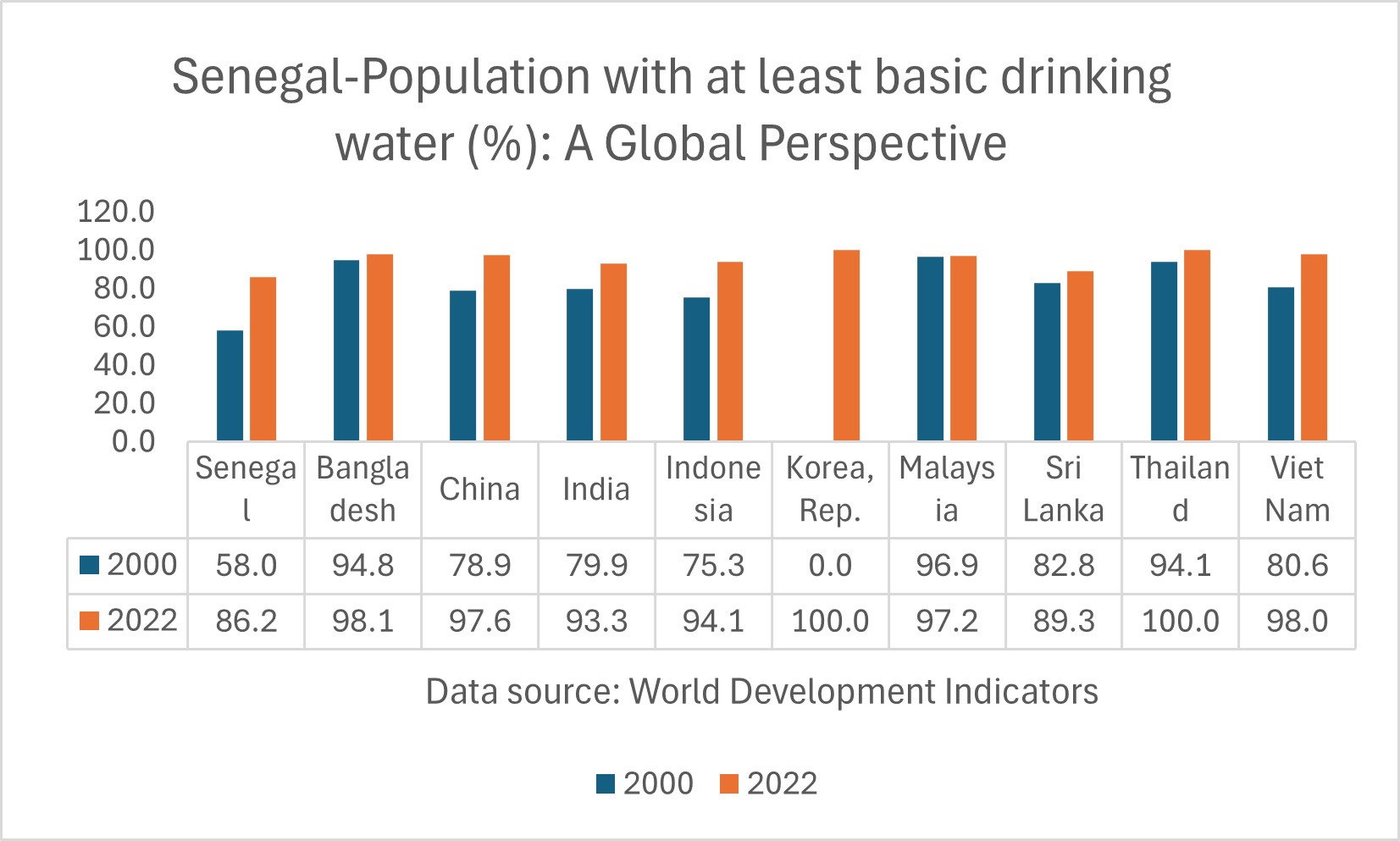
Senegal – Proportion of rural population served with at least basic water: A Global perspective
Senegal is facing a significant crisis, with 23 percent of its rural population lacking access to drinking water facilities in 2022, affecting around 2 million people who are deprived of safe drinking water essential for their health. In stark contrast, countries like Thailand and Bangladesh have achieved nearly universal access for their rural populations. This disparity highlights the urgent need for transformative action in Sub-Saharan Africa, emphasizing the importance of addressing water accessibility and sustainability to ensure fair access to this vital resource for everyone.

Senegal-Access to electricity
Senegal-Access to electricity (% of population)
In 2022, proportion of population with access to electricity for Senegal was 67.9 %. The proportion of population with access to electricity of Senegal increased from 37.7% in 2000 to 67.9% in 2022, an absolute change of 30.2 pp between 2000 and 2022.
Senegal- Access to electricity (% urban population)
In 2022, proportion of urban population with access to electricity for Senegal was 96.6%. The proportion of urban population with access to electricity of Senegal increased from 74.6% % in 2000 to 96.6% in 2022, an absolute change of 22 pp between 2000 and 2022.
Senegal-Access to Electricity (% rural population)
In 2022, proportion of rural population with access to electricity for Senegal was 43.4 %. The proportion of rural population with access to electricity of Senegal increased from 12.8% % in 2000 to 43.4% in 2022, an absolute change of 30.6 pp between 2000 and 2022.
Senegal -proportion of total population with access to electricity: A Global Perspective
In 2022, about 32 percent of Senegal’s population, or over 5 million people, lived without electricity, a crucial service for daily life and economic activities. This stark reality contrasts sharply with countries like Vietnam, Thailand, Sri Lanka, and Malaysia, which have achieved 100 percent electricity access. Such disparities highlight the pressing need for reforms in Sub-Saharan Africa to enhance living conditions of the people. Reliable electricity is essential for development, improving health and education, and driving economic growth. Addressing this issue can open the door to a brighter future and promote social and economic progress in these communities.
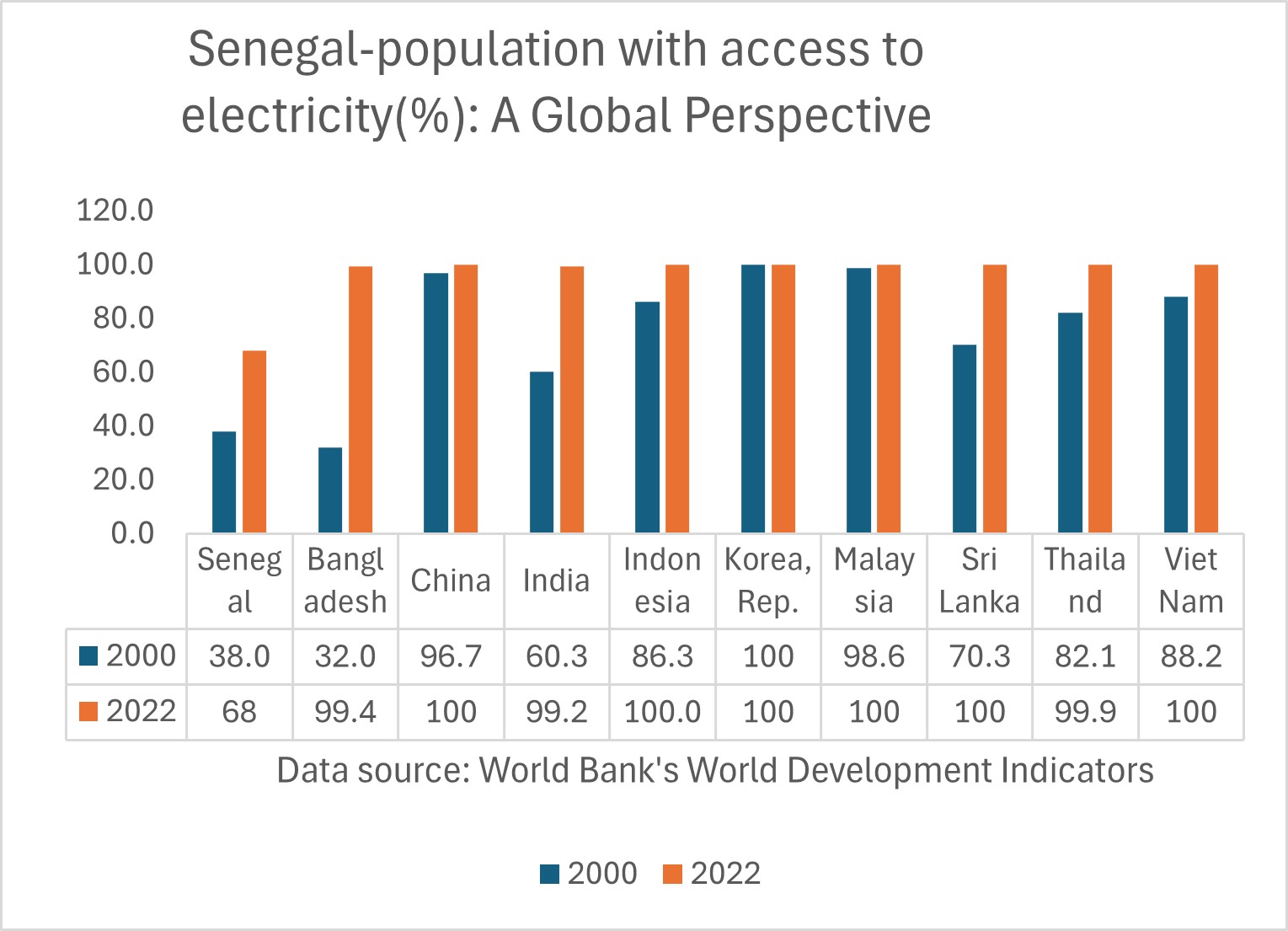
Senegal -Proportion of rural population with access to electricity: A Global Perspective
In 2022, about 57 percent of the rural population in Senegal, or roughly 5 million people, endured the harsh reality of living without electricity, highlighting a sharp contrast with countries like Vietnam, Thailand, and Sri Lanka, where all rural residents benefit from reliable access to this crucial resource. In contrast, 99 percent of rural communities in India and Bangladesh thrive with electricity, fostering personal growth and communal innovation. These alarming figures represent more than just statistics; they reveal a pressing need for significant reforms in governance throughout Sub-Saharan Africa to ensure that every community achieves consistent access to electricity, a fundamental necessity for a sustainable and equitable future.
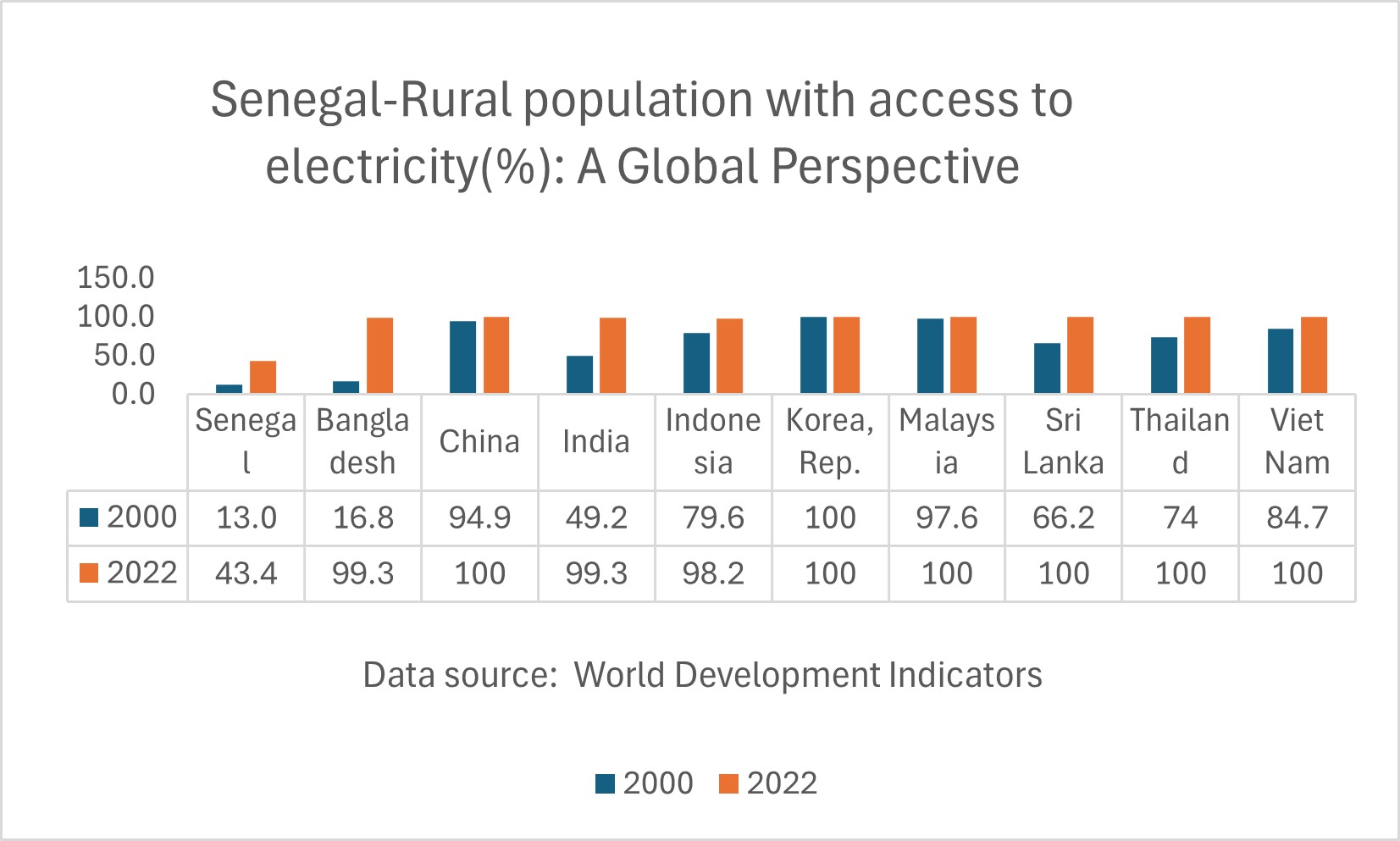
Senegal-Health-outcomes
Senegal-Life expectancy: A Global Perspective
As we analyze life expectancy trends over the past seven decades, it is clear that while significant advancements have improved human longevity and health, considerable disparities remain, particularly in Sub-Saharan Africa. The global average life expectancy for newborns has risen from 47 years in 1950 to 71 years by 2021; yet, many countries in Sub-Saharan Africa have seen minimal gains. For example, Senegal’s life expectancy increased from 40 years in 1960 to 68 years in 2022, highlighting ongoing challenges. In contrast, South Korea’s life expectancy skyrocketed from 54 years in 1980 to 83 years in 2022, while the Maldives rose from 39 years in 1960 to 81 years in 2022. The persistent low life expectancy in Sub-Saharan Africa underscores complex issues like chronic poverty, inadequate healthcare funding, and governance deficiencies, emphasizing the urgent need for transformative initiatives to foster a sustainable and equitable future for these communities.
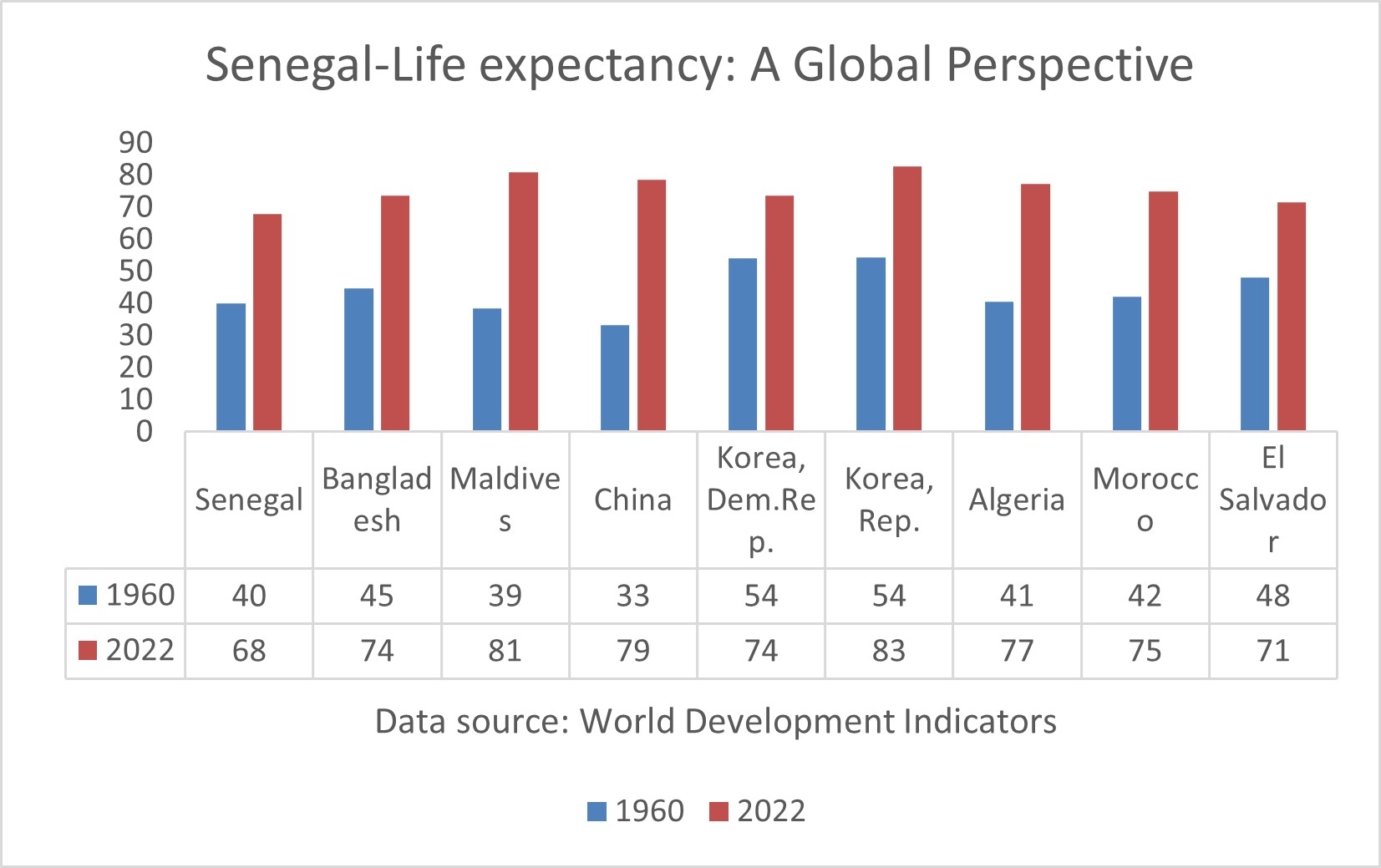
Senegal- Mortality rate, under-5 (per 1000 live births): A Global Perspective
Since 1950, child mortality rates worldwide have significantly declined, driven by improvements in living standards, healthcare access, nutrition, and safe drinking water. In developed regions like Europe and North America, rates have dropped to below four percent, reflecting effective healthcare and stable socioeconomic conditions. Although many developing countries in South America, Asia, and Africa have made progress, Sub-Saharan Africa still faces slow advancements. For instance, Senegal reduced its under-five mortality rate from 205 in 1980 to 37 in 2022. Conversely, Bangladesh decreased its rate from 206 in 1980 to 29 in 2022, while India reduced its rate from 169 in 1980 to 29 in 2022. These statistics underscore the ongoing challenges due to inadequate healthcare systems and highlight the urgent need for structural reforms in governance across Sub-Saharan Africa to effectively reduce child mortality and improve health outcomes.
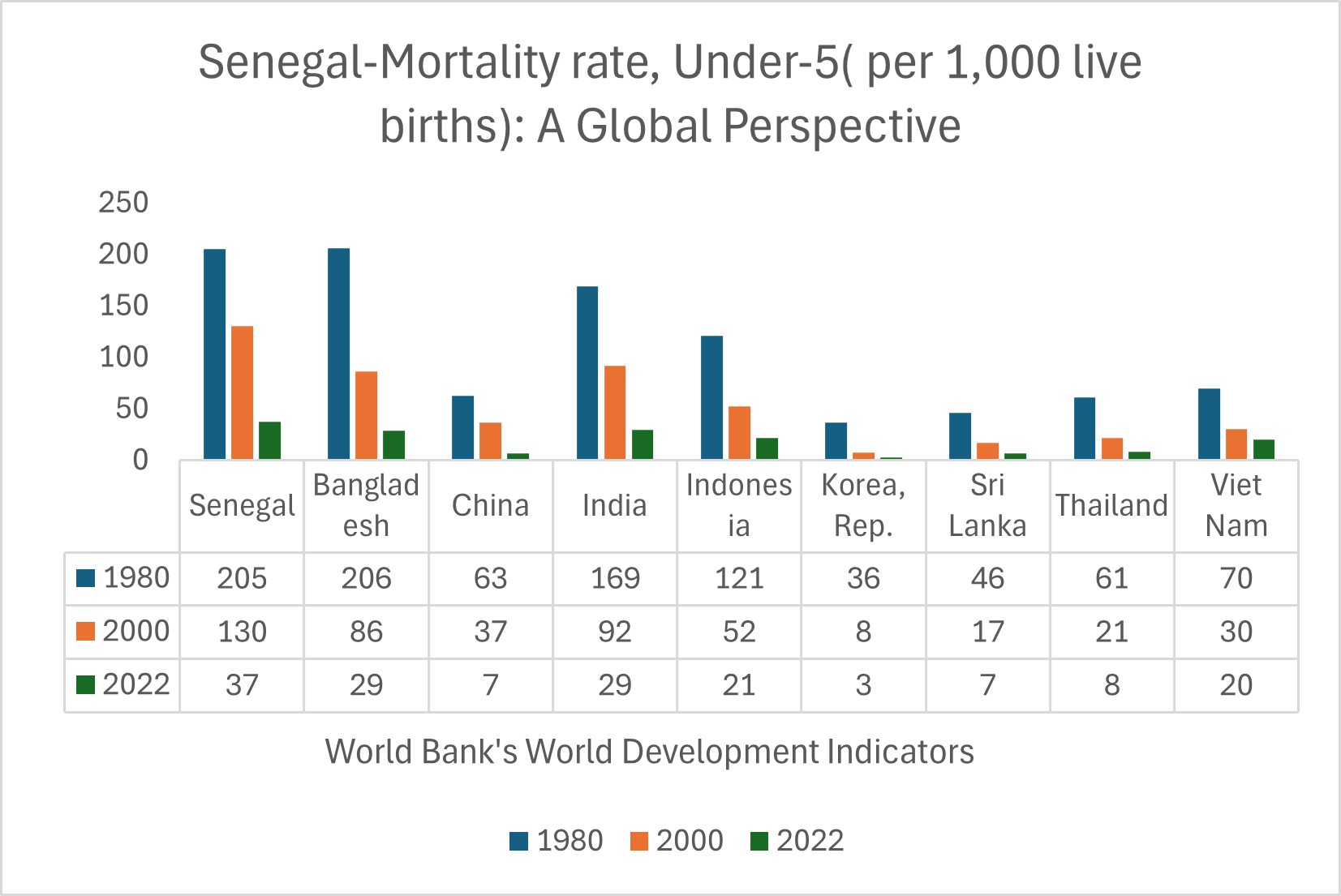
Senegal- Maternal mortality ratio(per 100,000 live births): A Global Perspective
Senegal’s maternal mortality ratio has decreased from 638 in 2000 to 261 in 2020, yet it remains distressingly high, reflecting the significant challenges that mothers face across the country. This progress is overshadowed by the much lower maternal mortality ratios in Bangladesh, India, and Vietnam, which recorded figures of 123, 103, and 46 in 2022, illustrating a stark disparity. These troubling statistics reveal critical gaps in healthcare systems and the ongoing underfunding that afflicts numerous Sub-Saharan African nations, emphasizing the urgent need for comprehensive improvements in health infrastructure to ensure the safety and well-being of mothers and children in Senegal.
